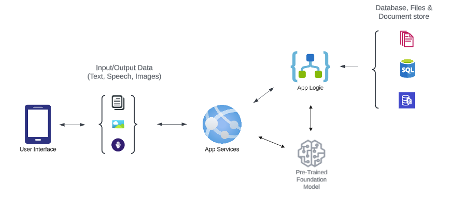
Why You Should be Thinking of AI for Your Business
By Thayer Tate
Businesses today are constantly seeking innovative solutions to outpace their competitors, enhance efficiency, and deliver unmatched customer experiences. One technological advancement stands out in this quest, and 35% of global companies are using it: Artificial Intelligence (AI). In this article, we will explore the significance of AI for business and why you should consider integrating it into your operational strategy.
The Rise of AI Tools for Business
We encounter AI daily—from Siri on our phones to the recommendation systems on Netflix.
The past decade has witnessed a surge in computational power, vast data access, and breakthroughs in algorithms, propelling AI from a mere buzzword to an industry-altering powerhouse.
AI is the talk of various sectors as leaders scramble to grasp its implications for their respective industries and organizations. This rapid evolution has left many leaders trying to catch up with the endless possibilities of AI for business, making it a challenge to devise a robust AI strategy. Nonetheless, the urgency to integrate AI for business purposes is paramount. Executives and boards are inquiring about leveraging AI for innovation and cost-efficiency, while employees are curious about AI’s potential impact on their roles.

Understanding the Potential of AI for Business
Artificial Intelligence (AI), a term coined back in 1955 by emeritus Stanford Professor John McCarthy, was defined by him as “the science and engineering of making intelligent machines.” This field aims to simulate a wide range of human cognitive processes, including learning, problem-solving, and decision-making. Most commercial organizations use the AI solution of Machine Learning or a more specific subset of Machine Learning, called Deep Learning.
While there are different types of AI, Generative AI is causing significant disruption across many industries today. Generative AI is an application of Deep Learning that utilizes a neural network trained using a massive dataset.
The highly trained AI is created as a “foundation model” that can later be adapted to many different generative tasks without having to separately train a new AI for each target use case. For example, the GPT-3 and GPT-4 models from Open AI on which ChatGPT is built are examples of foundation models trained for generative tasks.
The foundation training data sets include human languages and when combined with modern computing power and recent neural network advancements, modern AI models can now accept complex language-based instructions and generate similarly sophisticated written outputs. For the first time in history, we are at a point where we can train computers to interface with humans using natural language. These new capabilities simply extend a diverse field of evolving AI and Machine Learning solutions that are tackling a myriad of complex data-driven problems through analyzing, learning, and predicting data.

The implications of AI’s growth are far-reaching, even in economic terms. Recent projections suggest an impressive surge in the global AI market, with expectations to reach $184 billion in 2024. This expansion reflects AI’s substantial influence across various industries, from fledgling startups to established multinational corporations. The integration of AI for business not only revolutionizes operational processes but also propels innovation, fortifies competitiveness, and reshapes the business landscape.
Is AI Good for Businesses?
Answering whether AI is good for business or not is a complicated question. However, we’ve gathered some insights to help clarify the potential benefits and drawbacks of AI for business.
The Benefits
Automation
AI’s automation capabilities can significantly reduce manual tasks and boost employee performance. For highly skilled workers who utilize AI for business, performance can improve by up to 40% compared to those who don’t. This improvement stems from AI’s ability to handle repetitive tasks efficiently, allowing employees to focus on more strategic and creative work.
Reducing Mistakes
In addition to automating tasks, using AI for business purposes reduces the risk of errors that typically arise from manual processes. Over 90% of respondents in a survey reported that AI contributed to their company’s success by minimizing mistakes. This reduction in errors not only drives growth but also frees up time for employees to engage in more valuable activities each week.
Data Processing
AI excels at rapidly and accurately processing large datasets, extracting valuable insights that inform business decisions. This capability enables companies to make data-driven decisions with greater confidence, enhancing overall operational efficiency and strategic planning.
The Drawbacks
Lack of Empathy
AI operates on algorithms and data patterns, lacking the emotional depth and intuitive understanding that underpin genuine empathy. While advancements in natural language processing and sentiment analysis allow AI to mimic empathetic communication to some extent, these interactions are still clearly machine-driven.
Cost
One of the most significant drawbacks of implementing AI for business is its high cost. The development and deployment of AI solutions can range from $20,000 to several million dollars, depending on the complexity and scope of the project. While the initial investment can be daunting, the long-term benefits of streamlined workflows and increased efficiency often justify the expense. However, the upfront cost can be prohibitive for some businesses.
Security
Cybersecurity is a major concern for businesses relying on AI systems. Cyberattacks can cause significant financial damage and raise questions about a company’s security measures. AI systems are not immune to these threats; hackers continually seek ways to exploit vulnerabilities, potentially gaining access to sensitive information.
To mitigate these risks, businesses must regularly update their AI systems with the latest algorithms and security measures. Staying ahead of cyber threats is crucial to maintaining the integrity and functionality of AI systems and protecting valuable data.
What Can AI Do for Business?
AI’s transformative potential spans across various business functions, offering AI tools for business and capabilities that enhance efficiency, productivity, and decision-making. Here’s how AI is revolutionizing key areas in the business landscape:
Customer service
AI-powered conversational assistants are game-changers in customer service, boosting support agents’ productivity by 14%. Generative AI is also making waves in sales and service sectors, with 61% of salespeople confident that AI enhances their customer service capabilities. Similarly, 63% of service professionals believe AI for business helps them respond to customer needs more swiftly, illustrating AI’s role in creating faster and more efficient customer interactions.
Content creation
The impact of AI on content creation is profound, drastically reducing the time required to produce high-quality content. For instance, bloggers using AI tools for business reported taking an average of 2.81 hours to write a 2,000-word blog post, compared to 4.02 hours for those without AI assistance. This efficiency enables content creators to produce more work in less time while also focusing on creativity and quality.
Human Resources
AI is reshaping Human Resources by streamlining processes and enhancing decision-making.
HR professionals using AI for recruitment benefit from its ability to generate job descriptions (65%), customize job postings (42%), and automate resume reviews and candidate searches (33%). This automation leads to more efficient recruitment processes, better candidate experiences, and data-driven hiring decisions.
How to Use AI for Business
There are many different types of AI solutions available today and most organizations and executive leaders are turning significant attention to evaluating how to meaningfully capitalize on the capabilities of AI. Below we present a few different adoption strategies that you could implement individually or concurrently to capitalize on the capabilities of AI that are available today.
Implement an Out-of-Box AI Tool within your Organization
If your primary objective for using AI is to create efficiencies within your organization, then empowering your team with an AI tool for business may be the way to go. However, there are a variety of AI tools for business on the market, some general purpose, and some very specific to business workflows, so you may want to start by breaking down your teams by their focus area and then looking at which tools are the best fit for their individual teams. For example, tools like ChatGPT, Jasper.ai, and Microsoft Copilot may be helpful to teams that generate content and documents but may not be the ideal toolset for other teams such as recruiting, accounting, or engineering.

When considering how AI tools could create efficiencies within your organization, it’s helpful to understand that most of the out-of-box AI tools that are being discussed these days are based on a GPT model. GPT models are neural network models trained on a large data set, including languages, which allows them to understand language-based input and generate various types of output including written content, images, and even software code. Regardless of your specific tool of choice, below are some common uses of generative AI tools that have been trained on large language data sets to create a foundation model:
- Sentiment Analyzing – A GPT model can analyze text to determine the emotional tone and sentiment expressed, helping businesses understand customer opinions and make data-driven decisions.
- Chatbots – GPT-powered chatbots can engage in natural and human-like conversations, providing customer support, information, and assistance 24/7.
- Language Translation – GPT models can swiftly translate text between languages, aiding businesses in communicating effectively with international clients and partners
- Text Classification – GPT models excel at categorizing and tagging text, streamlining tasks like content organization, spam detection, and topic labeling.
- Code Generation – GPT models can generate code snippets, scripts, and programming-related content, saving time for developers and assisting in software development tasks.
- Named Entity Recognizing – GPT models can identify and extract specific entities like names, dates, and locations from text, enhancing data analyzing and organization.
- Question/Answer Research- GPT models can comprehend, and answer questions based on vast amounts of text, enabling efficient research and knowledge retrieval.
- Text Rewriting – GPT models can help in paraphrasing and rewriting text, making it easier to produce unique content, avoid plagiarism, and repurpose existing material.
- Content Generation – GPT models extended to handle multimodal inputs can create diverse content such as image captions, audio transcriptions, and more, enhancing creativity in content production.
There are several known risks and dangers of using AI-generated content. Without proper AI education and governance for your users, it could create risks and liability for your organization.
We recommend you seek assistance or perform significant due diligence regarding the risks before fully incorporating AI tools into your day-to-day processes.
Integrate or Customize a Pre-Trained AI Model for your Needs
An out-of-box AI tool can be an extremely helpful aid for your team members or for completing one-off tasks. However, these same AI capabilities can also be customized and even integrated with your automated systems to fulfill your specific and unique requirements. If you want to move beyond ChatGPT variants and build customized solutions that use AI for business, consider integrating an AI model into new or existing software within your organization.
For example, the diagram shows how a pre-trained AI model could be incorporated into an existing application that you already have in place today.

As shown in the diagram, the software could have standard user interface such as a web or mobile app where users can submit information to the app via text, image, or voice inputs. In a traditional application, the information would be received and processed by server-side app logic and response returned to the user as shown by the top path. An enticing extension of this architecture would be incorporating AI into these existing application flows. In the architecture shown above, your App Services layer could optionally route certain requests through an AI model and its response returned to the calling application. If needed, you could also add pre or post processing logic around the call to the AI model for additional refinements.
Modern AI models also provide various methods to customize and adapt them without having to train up your own model. For example, techniques such as Prompt Engineering, Prompt Chaining, Function Calling, Plugins, Fine Tuning, and Embeddings can be used to tailor and extend a model to solve for your unique use cases. Each of these techniques bring additional capabilities to the table beyond what you can do with an out-of-box AI tool like ChatGPT.
Train a Machine Learning Model on your own Data
If you have your own set of data that you would like to mine for insights or use for predictive modeling, then you may want to consider training AI for business intelligence. In many situations, a large language model or generative AI solution is not the best approach for solving data-centric challenges and you would be better served by selecting and training an existing machine learning model that has been proven effective and efficient for your particular objectives. For example, you might have opportunities to use purpose-built Machine Learning models for a variety of use cases including data analysis, predictive modeling, device automation, and image recognition, none of which require generative AI approaches.
There are too many machine learning approaches and models to list here but you can be sure that this branch of artificial intelligence has significant research depth and diversity. If you have your own data set available for training a model, then you should definitely investigate this adoption approach as a means of gaining a competitive edge.

Starting Your Business AI Journey
For business leaders to effectively leverage AI, it’s essential to first be equipped with a solid understanding of AI for business capabilities, potential risks, and best adoption strategies. We often recommend an AI for business education session for business leaders as a good place to start to inform leaders about the capabilities and common use cases for AI. This foundational knowledge enables leadership and key organizational stakeholders to better evaluate and identify meaningful AI opportunities within your organization, which is usually the first step in identifying your AI business strategy.
Once your leaders and key stakeholders have identified a prospective list of key AI business opportunities, the next step is to collaborate with an expert partner to complete an AI Suitability Assessment. The goal of the AI Suitability Assessment is to review the prospective business opportunities to evaluate the technical approach, viability, relative effort, and likelihood of success for each opportunity. The results from the Assessment will help your organization prioritize which opportunities to pursue first based on these factors and the business return on investment.
Embracing AI for Business Success
By integrating AI, businesses can not only address current challenges but also drive innovation, ensuring they stay at the forefront of their industry.
AI’s integration in business isn’t just a passing trend; it’s a strategic imperative. As AI technologies continue to evolve, they offer businesses unparalleled advantages, making now the perfect time to embark on the AI journey.
If you’re looking for a partner who can empower your business for the future through AI and machine learning, contact SOLTECH. We provide end-to-end support, from strategy development to deployment, ensuring that your AI and ML initiatives align with your business goals and deliver tangible outcomes. Discover how our services can drive your success.
Thayer Tate
Chief Technology Officer Thayer is the Chief Technology Officer at SOLTECH, bringing over 20 years of experience in technology and consulting to his role. Throughout his career, Thayer has focused on successfully implementing and delivering projects of all sizes. He began his journey in the technology industry with renowned consulting firms like PricewaterhouseCoopers and IBM, where he gained valuable insights into handling complex challenges faced by large enterprises and developed detailed implementation methodologies.
Thayer is the Chief Technology Officer at SOLTECH, bringing over 20 years of experience in technology and consulting to his role. Throughout his career, Thayer has focused on successfully implementing and delivering projects of all sizes. He began his journey in the technology industry with renowned consulting firms like PricewaterhouseCoopers and IBM, where he gained valuable insights into handling complex challenges faced by large enterprises and developed detailed implementation methodologies.
Thayer’s expertise expanded as he obtained his Project Management Professional (PMP) certification and joined SOLTECH, an Atlanta-based technology firm specializing in custom software development, Technology Consulting and IT staffing. During his tenure at SOLTECH, Thayer honed his skills by managing the design and development of numerous projects, eventually assuming executive responsibility for leading the technical direction of SOLTECH’s software solutions.
As a thought leader and industry expert, Thayer writes articles on technology strategy and planning, software development, project implementation, and technology integration. Thayer’s aim is to empower readers with practical insights and actionable advice based on his extensive experience.



